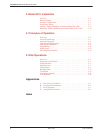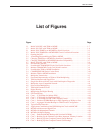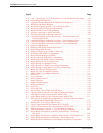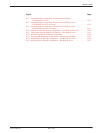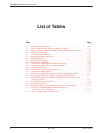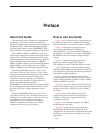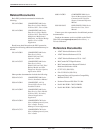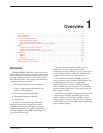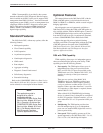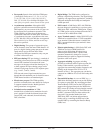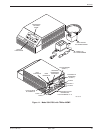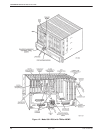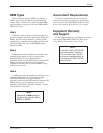
COMSPHERE 3600 Series Data Service Units
1-2 March 1999 3610-A2-GB41-60
LPDA-2 interoperability is provided by the systems
network architecture (SNA) Diagnostic Interface option
that is installed on the DSU circuit card. It supports DSU
management from IBM’s NetViewt host-based network
management system (NMS), as well as management from
a Paradyne NMS or the DSU’s diagnostic control panel
(DCP). This option also supports DBM (including the
DBM-V, DBM-S, and DBM-D), TDM, MCMP, and
digital bridge capability.
Standard Features
The 3600 Series DSU, without any options, offers the
following features:
• Multispeed operation.
• Clear Channel capability.
• LADS operation.
• Asynchronous operation.
• Nondisruptive diagnostics.
• NMS control.
• Rate adaption.
• Aggregate switching.
• Diagnostic Control Panel control.
• Full tributary diagnostics.
• External dial backup.
Refer to the COMSPHERE 3600 Series Data Service
Units, Models 3610 and 3611, Operator’s Guide, which
can be ordered, for a description of these features.
NOTE
This applications guide is
designed to be used in
conjunction with the
COMSPHERE 3600 Series Data
Service Units, Models 3610 and
3611, Operator’s Guide
and the
COMSPHERE 3600 Series Data
Service Units, Models 3610 and
3611, Dial Backup Module and
SNA Diagnostic Interface
Options, Applications Guide.
Optional Features
This manual discusses the 3600 Series DSU with the
TDM or MCMP option; it also includes discussion of
DBM-Vs, DBM-Ss, or DBM-Ds, which are used in digital
bridging applications.
Most diagnostic tests and commands available to a
3600 Series DSU without the TDM or MCMP option are
also available with the TDM or MCMP option. Control of
a TDM/MCMP/digital bridge session can be performed
from the DCP, from an Async (Asynchronous) Terminal,
or from a COMSPHERE 6700 or 6800 Series NMS.
Options that provide point-to-point dial backup
capability and LPDA-2 interoperability without the TDM
or MCMP option are discussed in the COMSPHERE
3600 Series Data Service Units, Models 3610 and 3611,
Dial Backup Module and SNA Diagnostic Interface
Options, Applications Guide.
DSU with TDM Capability
TDM capability allows up to six independent ports to
share one standard digital point-to-point facility. TDM
capability provides the following features:
• Port capacity. The TDM option allows up to six
independent ports. One port is provided on the
DSU, and five EIA-232 ports are provided on the
TDM circuit card. (For a Modular 3611 DSU, V.35
interface is at the top of the 6-port connector
module.)
There are two versions of the Model 3610
TDM/Flex: the 2-port TDM/Flex and the 6-port
TDM/Flex. With one of these features installed,
each port can be set as either an EIA-232 or V.35
interface. When a port other than Port 1 is used for
V.35 operation, a cable adapter is required (feature
number 3000-F1-510).
When a Model 3610 TDM/DSD (digital sharing
device) is ordered, Ports 2 through 6 are configured
for EIA-232 operation. With these models, you can
select either EIA-232 or V.35 operation for this port
group.
• Multiplexing. The TDM option provides time
division multiplexing for up to six independent
ports over one standard DDS (digital data service)
point-to-point facility.
• Line speeds. TDM capability operates at all line
speeds supported by the 3600 Series DSU: 2.4, 4.8,
9.6, 19.2, 38.4, 56, and 64 kbps full-duplex.



